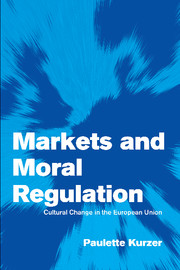Book contents
- Frontmatter
- Contents
- List of tables
- Preface
- 1 Markets versus morality
- 2 Binge drinking: the evolution of alcohol control policy in Finland
- 3 Our greatest social problem: anti-alcohol policy in Sweden
- 4 Nordic morality meets the European Union
- 5 Permissive pragmatism: drug control policy in the Netherlands
- 6 Harm reduction meets the EU: from public health to public order
- 7 Irish moral conservatism and European sexual permissiveness
- 8 The emergence of a European morality?
- Bibliography
- Index
3 - Our greatest social problem: anti-alcohol policy in Sweden
Published online by Cambridge University Press: 16 October 2009
- Frontmatter
- Contents
- List of tables
- Preface
- 1 Markets versus morality
- 2 Binge drinking: the evolution of alcohol control policy in Finland
- 3 Our greatest social problem: anti-alcohol policy in Sweden
- 4 Nordic morality meets the European Union
- 5 Permissive pragmatism: drug control policy in the Netherlands
- 6 Harm reduction meets the EU: from public health to public order
- 7 Irish moral conservatism and European sexual permissiveness
- 8 The emergence of a European morality?
- Bibliography
- Index
Summary
A good society, according to Nordic definitions, checks human passions that produce drunkenness, lewdness, and rituals of anti-social behavior. A society that fails to civilize its members confronts self-centered hedonism. Married to a strong belief in social engineering, successive generations of elected officials endeavored to minimize the consumption of alcohol and to ban recreational drug-taking. Sweden, like Finland, was part of the vodka-belt and occasions of sociability were often an excuse to get extremely drunk. For more than a century, this style of drinking provoked little concern although distilled spirits were the subject of a lengthy political struggle between the Swedish monarchy and the peasantry. But the bone of contention was the discretionary right to impose excise taxes on distilled liquor and to sell surplus spirits. The Swedish monarchy depended on alcohol taxes to finance its budget and repeatedly tried to take away from the peasant communities the right to produce and sell vodka. In 1824, the monarchy admitted defeat and the production, sale, and distribution of spirits fell into private hands. By the 1850s, according to the official historiography of Swedish drinking, the nation was succumbing to permanent drunkenness, as each man, woman, and child was said to consume as much as 46 liters of brännvin or Swedish vodka per year, which was the equivalent of nearly half a liter of pure alcohol per week. Other figures cited the annual production of 22 million gallons of pure alcohol for a population of 3 million.
Rather suddenly, drinking rituals, which dated from the introduction of spirits in Sweden in the eighteenth century, became a major concern in the late nineteenth century.
- Type
- Chapter
- Information
- Markets and Moral RegulationCultural Change in the European Union, pp. 49 - 72Publisher: Cambridge University PressPrint publication year: 2001



